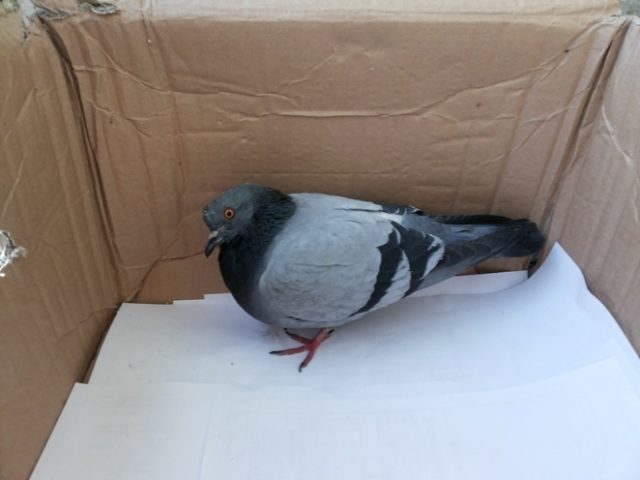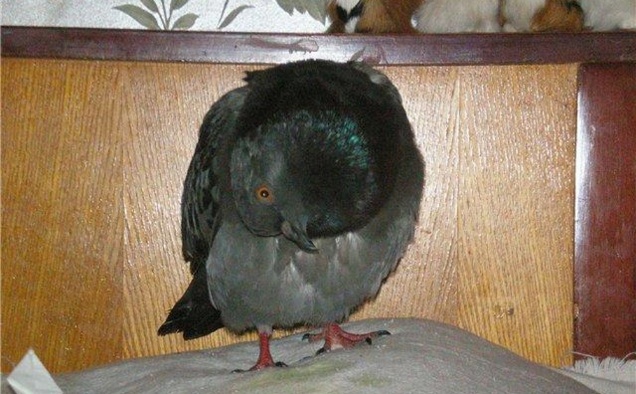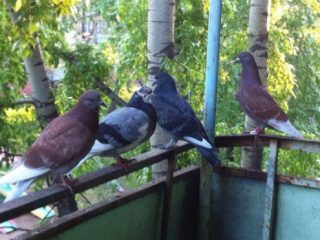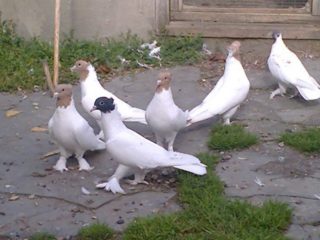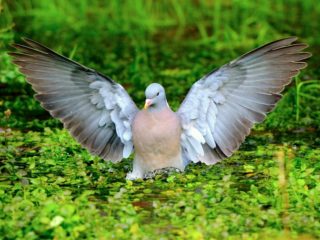Content
- 1 What is a pigeon whirligig
- 2 Causes of Newcastle disease in pigeons
- 3 The course of the pigeon whirligig
- 4 Symptoms of Newcastle disease in pigeons
- 5 How and what to treat a pigeon whirligig
- 6 How to process a dovecote after a twirl
- 7 Is a pigeon whirligig dangerous for people
- 8 Preventive actions
- 9 Conclusion
The most common disease in pigeons that causes damage to the nervous system and does not respond to treatment is Newcastle disease. In the people, the disease is called "whirligig" because of the peculiarities of the movement of the pigeon affected by the disease. A twig in pigeons is capable of destroying all young growth and severely damaging adult birds.
What is a pigeon whirligig
Newcastle disease is of Asian origin. For some countries in Asia, it is endemic. The Europeans "got to know" her on the island of Java. In the middle of the twentieth century, the disease spread throughout the world. All birds, including pigeons, are susceptible to the Asiatic plague. In cities, outbreaks of epizootics among pigeons sometimes even occur.
The name "pigeon whirligig" exists only among Russian-speaking pigeon breeders. They aptly noticed one of the most striking symptoms in the last stage of the development of the disease: the movement of the pigeon in a circle. Because of the similar name, one might think that this is a specific disease of pigeons, not found in other birds. But Newcastle disease is known to all poultry farmers. Other names for this disease are less "famous":
- pseudo-plague;
- Filaret disease;
- Asian plague of birds;
- Renikhet disease;
- NB.
Pseudo-plague is caused by viruses that affect the respiratory, digestive and central nervous systems. Chickens are most commonly affected by Newcastle disease. There is a version that different strains of viruses of the Paramyxoviridae family cause pigeon twirl and Newcastle chicken disease, and chickens rarely become infected from pigeons.
Large poultry farms located near cities, upon the news of an outbreak of epizootics among urban pigeons, immediately vaccinate all their livestock. Or they do it preventively, if the farm is breeding.
Causes of Newcastle disease in pigeons
If we take a broad approach to this issue, then the reasons for infection with a swivel are in the untidiness of pigeons. It is theoretically believed that these birds are granivorous, but pigeons have little knowledge of people's opinions. Unlike a chicken, a pigeon cannot peck fresh carrion, but in rotting corpses, the virus remains active for 3 weeks. During this time, only feathers and bones remain from the corpse of another bird. Accordingly, already 2-3 days after the death of a relative, the pigeon can taste the infected meat. This is one route of infection.
Also, virus infection occurs:
- upon contact with a sick bird;
- directly through the droppings of a sick individual: pigeons do not really understand where they step;
- through water and feed contaminated with droppings;
- intrauterine infection.
The latter is possible if the dove is sick. The virus remains in the egg until the hatching of the pigeon. And such a chick is doomed.
The course of the pigeon whirligig
In a whirligig, there are 3 types of course and 2 forms of the disease. The form can be typical, that is, with the manifestation of clinical signs, and atypical: latent. Atypical whirligig is possible in a flock of different ages, where birds have different levels of immunity. Strictly speaking, no one will notice the disease in this case. Mostly young pigeons are sick.
The flow of a typical form can be hyperacute, subacute and acute.
Symptoms of Newcastle disease in pigeons
The incubation period is 3-12 days; chicks may have 18 hours. The duration of the latent period depends on the strength of the pigeon's immunity.
With a hyperacute form, the whirligig affects all pigeons within 1-3 days. Clinical signs among unvaccinated pigeons in hyperacute form are pronounced.
Few people measure the temperature of birds, so fever in an acute form is unlikely to be noticed.
The rest of the signs are already difficult to ignore, especially if the entire dovecote is infected:
- apathy;
- decreased appetite;
- suffocation in 40-70% of birds;
- diarrhea in 88% of diseased pigeons;
- stringy saliva from the mouth;
- conjunctivitis;
- sneezing.
Often, pigeons lie with their beaks on the floor. The presence of suffocation can be determined by the way the pigeon stretches its neck and opens its beak, making similar swallowing movements. Fecal matter contains a large percentage of uric acid (white color of diarrhea). If the whirligig has struck the kidneys, the diarrhea will be with a lot of water. In the acute form, deaths can reach 90%.
The subacute course of the whirligig is just what is usually shown on the video: damage to the central nervous system. Signs of a subacute course:
- increased excitability;
- impaired coordination of movements;
- wobbly gait;
- paralysis;
- twisting of the neck;
- sagging wings and tail;
- limb damage.
The virus has no preferences and affects all organs. With different courses of the disease, certain symptoms are only more pronounced, therefore, nervous phenomena do not mean automatic cancellation of damage to the lungs and intestines. Everything will be together, but something will be stronger, something weaker.
In the atypical form, the symptoms are hidden until the central nervous system is damaged. The disease is noticed when the pigeon's head is already turned 180 ° or thrown back.
Diagnostics
Symptoms of a pigeon whirligig are similar to those of almost all specific avian diseases. Therefore, the pseudo-plague must be differentiated from other diseases:
- flu;
- laryngotracheitis;
- spirochetosis;
- infections mixed with pasteurellosis, smallpox, respiratory mycoplasmosis, colisepticemia and others;
- poisoning.
Diagnostics is carried out in the laboratory. To isolate the virus, use:
- liver;
- spleen;
- trachea;
- brain;
- blood serum.
Allantoic fluid is taken from the dead embryos.
How and what to treat a pigeon whirligig
The pigeon whirligig does not respond to treatment due to the high infectivity of the disease. But there is one point. Pigeons with a swivel die not so much from the virus as from dehydration and exhaustion. Infected kidneys begin to expel water from the body. It is for this reason that there is a lot of clear liquid in the droppings of sick pigeons.
Due to the collapsed neck and impaired coordination of movements, the pigeon can neither eat nor drink. Usually sick birds are destroyed in milder forms of the whirligig. But if the pigeon has nothing to lose or the pigeons are very expensive, you can try to help them recover.
But you can alleviate the condition of the pigeon. It is not clear only why. The surviving pigeons will stop rushing and remain virus carriers for the rest of their lives.
At an advanced stage, when the pigeon's neck has already been twisted and paralyzed, it is useless to take any measures. In the earlier stages, sick birds are isolated from apparently healthy birds. The whole livestock is pierced with an immunostimulant. Still healthy birds are vaccinated against Newcastle disease for pigeons.
The rest of the "treatment" comes down to keeping the pigeon alive. For this, the bird is force-fed and watered. For feeding, you can use a mixture of coarsely ground barley, wheat and milk. The grain should not be ground into flour. The grain mixture is diluted with milk to a liquid state.
You need to feed the pigeon in portions of 4-5 ml every 1-2 hours.Water should be given according to the same standards. The duration of such a "treatment" for Newcastle disease in pigeons will depend on the strength of the bird's immunity.
How to process a dovecote after a twirl
The virus that causes pigeons to wiggle is very stable in the external environment. In boiling water, the virus is inactivated after a few seconds, in water with a temperature of 90-95 ° C - after 40 minutes, so there is no point in “scalding” the dovecote. While the boiling water reaches the wall, it will have time to cool down.
Vapors of formaldehyde will take effect after an hour, caustic soda solution 0.5% after 20 minutes, bleach with 1% active chlorine will take 10 minutes. Based on these data, it is most advisable to use bleach.
But before using the disinfectant solution, all droppings must be removed from the dovecote and burned. You also need to remember to move the pigeons to another place during processing. It is better to "drown" the removable inventory in a solution of bleach. Spray walls, boxes for nests with lime solution. It is better not to spare the liquid and spray until the surfaces are wet. After that, the solution must be allowed to dry naturally. Remove the inventory from the solution and rinse thoroughly with clean water.
There is a method of sterilizing a dovecote using gaseous disinfectants. The advantage of this method is that gas can penetrate everywhere. Minus: it is difficult to ensure the necessary sealing of the dovecote and the air temperature must be at least + 15 ° C. Especially when you consider that usually at least half of this structure is occupied by a mesh enclosure.
For gas disinfection, a mixture of dry iodine and aluminum powder is used. The norm is 0.1 g of iodine and 0.03 g of aluminum per 1 m³. Stir the mixture thoroughly, pour on a saucer and drip hot water.
After half an hour, the dovecote must be thoroughly ventilated.
A similar procedure can be carried out with chlorine. To do this, take 1 g of fresh bleach with an activity of 36% and mix it with 0.1 ml of turpentine. For processing, 15 minutes is enough. After the procedure, the room is ventilated.
Since the whirligig is very contagious and even after isolation of clearly sick pigeons, new sick ones will appear, the dovecote is disinfected every 4-7 days. Stop processing 30 days after the recovery or death of the last sick pigeon.
Is a pigeon whirligig dangerous for people
For humans, the pigeon whirligig is not dangerous, although people are susceptible to the virus. But usually a person infected with a pseudo-plague does not understand this, mistaking the illness for a cold or flu.
Preventive actions
The main preventive measure, as with most other infectious diseases, is the observance of sanitary standards. A good diet also reduces the likelihood of pigeons getting sick. Healthy pigeons have a higher body resistance.
The vaccine for pigeons is used if there are no individuals in the flock with obvious clinical signs of the disease. Since the wiggle is caused by several strains of varying degrees of "viciousness", several types of vaccines have been created. Some can only be used on adult pigeons. They are not suitable for young animals. Other vaccines are suitable for both young and adult pigeons.
General points also exist: pigeon immunity develops within 4 weeks after vaccination. It is necessary to vaccinate pigeons annually.
The number of doses in one bottle can also be different: from 2 to 50.
Conclusion
A pigeon twirl is one of the most dangerous and common diseases. Poultry can become infected with it from wild relatives. To prevent the extinction of the entire flock, it is necessary to observe the terms of vaccination of pigeons and disinfection of the dovecote.
